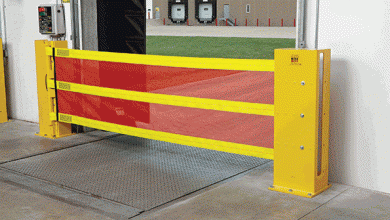Preventing Danger At The Loading Dock

Unfortunately, injuries and fatalities can and do happen on loading docks every year. Some of the most common causes of dock accidents involve the semi-trailer leaving the dock unexpectedly, which can result in the lift truck falling to the ground. Common causes of dock accidents include early departure, when a truck driver mistakenly drives away while a lift-truck operator is entering, leaving or still inside the trailer. Another cause is trailer creep. A trailer can move substantially under the weight of a lift truck entering and exiting a trailer.
Landing-gear collapse is another cause of dock accidents. Weak or damaged landing gear gives way, causing the trailer to pitch forward or to the side. Trailer pop-up, another cause, occurs when the weight of a forklift entering the rear of the trailer causes it to move forward and drop, causing the nose of the trailer to suddenly rise. Similarly, trailer upending, when the weight of the forklift sends the trailer's nose down, causes the rear end to move up and away from the building.
Forklift operators also may experience "dock shock," which is pain or spine injury resulting from long-term, repetitive vibrations. It can occur as operators enter and leave trailer beds via a leveler.
Having a systematic safety strategy in place can help reduce the potential for these kinds of onsite accidents and conditions. A loading-dock safety strategy can make your site a healthier place to work. A systematic approach that integrates a variety of products can help you achieve your safety goals.
When used with other safety equipment and procedures, you can create built-in safety checks simply by adhering to a specific order of operations. Your system might be as basic as following an ordered checklist when using equipment. Or you might choose equipment that interlocks or interconnects with other dock-safety components, ensuring that each step in your process is safely completed before beginning the next.
Before implementing a system, consider how you will address these four factors at your site:
There are several options available for securing trailers at the loading dock. Industrial wheel chocks, wheel-based restraints and automated restraint equipment are among the most common.
While wheel chocks provide some level of protection, they still can leave workers vulnerable in the event that a trailer lurches or its gear collapses. In icy or snowy conditions, they can slip, or they simply can become damaged over time.
Landing-gear collapse is another cause of dock accidents. Weak or damaged landing gear gives way, causing the trailer to pitch forward or to the side. Trailer pop-up, another cause, occurs when the weight of a forklift entering the rear of the trailer causes it to move forward and drop, causing the nose of the trailer to suddenly rise. Similarly, trailer upending, when the weight of the forklift sends the trailer's nose down, causes the rear end to move up and away from the building.
Forklift operators also may experience "dock shock," which is pain or spine injury resulting from long-term, repetitive vibrations. It can occur as operators enter and leave trailer beds via a leveler.
- ed03455354e61edd55e044ca729871f74c.jpg
Having a systematic safety strategy in place can help reduce the potential for these kinds of onsite accidents and conditions. A loading-dock safety strategy can make your site a healthier place to work. A systematic approach that integrates a variety of products can help you achieve your safety goals.
When used with other safety equipment and procedures, you can create built-in safety checks simply by adhering to a specific order of operations. Your system might be as basic as following an ordered checklist when using equipment. Or you might choose equipment that interlocks or interconnects with other dock-safety components, ensuring that each step in your process is safely completed before beginning the next.
Before implementing a system, consider how you will address these four factors at your site:
- Restraining the trailer.
- Communicating the status of the restraint to drivers and forklift operators.
- Protecting open docks.
- Creating a smooth transition from floor to trailer bed.
There are several options available for securing trailers at the loading dock. Industrial wheel chocks, wheel-based restraints and automated restraint equipment are among the most common.
While wheel chocks provide some level of protection, they still can leave workers vulnerable in the event that a trailer lurches or its gear collapses. In icy or snowy conditions, they can slip, or they simply can become damaged over time.
- ah258326462263b34df75741d930e48a9b.jpg